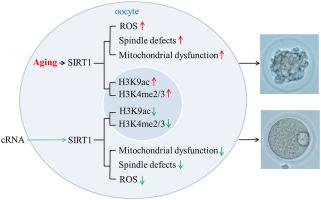Experimental Cell Research ( IF 3.3 ) Pub Date : 2021-01-05 , DOI: 10.1016/j.yexcr.2020.112421 Xupeng Xing , Jinjing Zhang , Teng Wu , Jingcheng Zhang , Yongsheng Wang , Jianmin Su , Yong Zhang

|
Postovulatory oocyte aging has a major influence on the development potential of embryos. Many antioxidants can delay oocyte aging by regulating the expression of SIRT1. However, there is a lack of knowledge on SIRT1 function in postovulatory oocyte aging. In vitro transcribed RNA of Sirt1 was injected into fresh oocytes to investigate the function of SIRT1 during postovulatory oocyte aging. In the present study, SIRT1 was found to be down-regulated in aged oocytes compared with fresh oocytes. Meanwhile the intensity of acetylation of H3K9 (H3K9ac) and H3K4 methylation increased in postovulatory aged oocytes. After the oocytes were injected with SIRT1 and aged for 12 h, the intensity of H3K9ac and H3K4 methylation markedly decreased compared with controls. Furthermore, SIRT1 overexpression also reduced the aging-induced oocyte morphological changes and reactive oxygen species accumulation, maintained the spindle normal morphology and attenuated the aging-associated abnormalities of mitochondrial function. The role of SIRT1 in protecting oocyte aging was diminished when oocytes with overexpressed SIRT1 were cultured with SIRT1 inhibitor EX-527. Briefly, these present results show that SIRT1 not only reduced the non-epigenetic changes such as abnormal oocyte morphology, ROS accumulation, spindle defects and mitochondrial dysfunctions but also regulated the epigenetic changes in order to maintain the quality of postovulatory aged oocytes.
中文翻译:

SIRT1减少表观遗传和非表观遗传变化,以维持小鼠排卵后老年卵母细胞的质量
排卵后卵母细胞衰老对胚胎的发展潜力有重大影响。许多抗氧化剂可以通过调节SIRT1的表达来延迟卵母细胞的衰老。然而,缺乏关于SIRT1在排卵后卵母细胞衰老中的功能的知识。Sirt1的体外转录RNA将其注入新鲜卵母细胞以研究SIRT1在排卵后卵母细胞衰老过程中的功能。在本研究中,与新鲜的卵母细胞相比,SIRT1在衰老的卵母细胞中被下调。同时,在排卵后的老年卵母细胞中,H3K9(H3K9ac)的乙酰化强度和H3K4甲基化的强度增加。卵母细胞注射SIRT1并老化12小时后,与对照组相比,H3K9ac和H3K4甲基化的强度明显降低。此外,SIRT1的过表达还减少了衰老引起的卵母细胞形态变化和活性氧的积累,维持了纺锤体正常形态并减弱了与衰老相关的线粒体功能异常。当SIRT1抑制剂EX-527培养过表达SIRT1的卵母细胞时,SIRT1在保护卵母细胞衰老中的作用减弱。简而言之,这些目前的结果表明,SIRT1不仅减少了非表观遗传学变化,例如异常的卵母细胞形态,ROS积累,纺锤体缺陷和线粒体功能障碍,而且还调节了表观遗传学变化,以维持排卵后老化的卵母细胞的质量。









































 京公网安备 11010802027423号
京公网安备 11010802027423号